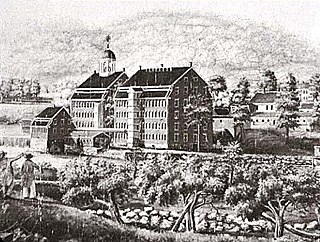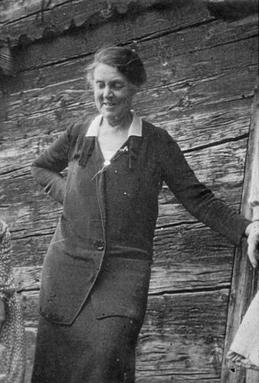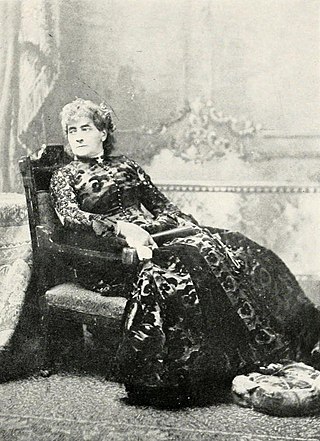
Frances Jane van Alstyne, more commonly known as Fanny J. Crosby, was an American mission worker, poet, lyricist, and composer. She was a prolific hymnist, writing more than 8,000 hymns and gospel songs, with more than 100 million copies printed. She is also known for her teaching and her rescue mission work. By the end of the 19th century, she was a household name.

The Waltham-Lowell system was a labor and production model employed during the rise of the textile industry in the United States, particularly in New England, during the rapid expansion of the Industrial Revolution in the early 19th century.
Kate Clifford Larson is an American historian and Harriet Tubman scholar. Her 2003 biography of Harriet Tubman, Bound for the Promised Land was one of the first non-juvenile Tubman biographies published in six decades. Larson is the consultant for the Harriet Tubman Special Resource Study of the National Park Service and serves on the advisory board of the Historic Context on the Underground Railroad in Delaware, Underground Railroad Coalition of Delaware.

The West End is a neighborhood of Boston, Massachusetts, bounded generally by Cambridge Street to the south, the Charles River to the west and northwest, North Washington Street on the north and northeast, and New Sudbury Street on the east. Beacon Hill is to the south, North Point is across the Charles River to the north, Kendall Square is across the Charles River to the west, and the North End is to the east. A late 1950s urban renewal project razed a large Italian and Jewish enclave and displaced over 20,000 people in order to redevelop much of the West End and part of the neighboring Downtown neighborhood. After that, the original West End became increasingly non-residential, including part of Government Center as well as much of Massachusetts General Hospital and several high rise office buildings. More recently, however, new residential buildings and spaces, as well as new parks, have been appearing across the West End.

The General Federation of Women's Clubs (GFWC), founded in 1890 during the Progressive Movement, is a federation of over 3,000 women's clubs in the United States which promote civic improvements through volunteer service. Many of its activities and service projects are done independently by local clubs through their communities or GFWC's national partnerships. GFWC maintains nearly 70,000 members throughout the United States and internationally. GFWC remains one of the world's largest and oldest nonpartisan, nondenominational, women's volunteer service organizations. The GFWC headquarters is located in Washington, D.C.

Americanization is the process of an immigrant to the United States becoming a person who shares American culture, values, beliefs, and customs by assimilating into the American nation. This process typically involves learning the American English language and adjusting to American culture, values, and customs.

Boston Latin Academy (BLA) is a public exam school founded in 1878 in Boston, Massachusetts providing students in grades 7th through 12th a classical preparatory education.

Helen Osborne Storrow was a prominent American philanthropist, early Girl Scout leader, and chair of the World Committee of the World Association of Girl Guides and Girl Scouts (WAGGGS) for eight years. She founded the First National Girl Scout Leaders' Training in Long Pond, Massachusetts; headed the leaders' training camp at Foxlease, UK; and donated the first of the WAGGGS World centres, Our Chalet.
The history of the Jews in Omaha, Nebraska, goes back to the mid-1850s.
Jewish Book Month is an important annual event in both the North American Jewish community and the publishing world. It is sponsored by the Jewish Book Council. It is held annually in the month before the Chanukah gift-giving season. Book fairs are held in most major cities with Jewish communities, albeit not in New York, and feature lectures by visiting authors.

Edith Guerrier (1870–1958) was a pioneer in the field of library science. Guerrier is best known for developing progressive library programs in the 1890s, including a reading program and a pottery studio for girls of Boston's North End, an urban immigrant center during the Progressive Era.
Pauline Revere Thayer (1862–1934) worked to improve immigrant conditions in Massachusetts and the US; represented Massachusetts in Republican party activities; and founded the Chilton Club in Boston in 1910. Born in Quincy, Massachusetts, in 1860 to Paul Revere III, she was a direct descendant of Paul Revere, and in that capacity performed civic and honorary duties in his memory. She married businessman Nathaniel Thayer III in 1887. Throughout her life, she pursued charitable endeavors. In 1896 she was treasurer of the Committee of Women of the Massachusetts Volunteer Aid Association, contributing to efforts benefitting American soldiers in the Spanish–American War. She also donated funds to the Massachusetts General Hospital. In 1910 she founded the private women's Chilton Club in Boston.

Fanny Janauschek was a Czech-born American stage actress.

North Bennet Street School (NBSS) is a private vocational school in Boston, Massachusetts. NBSS offers nine full-time programs, including bookbinding, cabinet and furniture making, carpentry, jewelry making and repair, locksmithing and security technology, basic piano technology, advanced piano technology, preservation carpentry, and violin making and repair, as well as a range of short courses and continuing education opportunities. Housed for more than 130 years at 39 North Bennet Street, near the Old North Church in Boston's North End, the School completed renovations on the former Police Station One and former City of Boston Printing Plant in September 2013. The subsequent move to the fully renovated 65,000 sq. ft. facility at 150 North Street brought all of their programs under one roof.
The Boston Women's Heritage Trail is a series of walking tours in Boston, Massachusetts, leading past sites important to Boston women's history. The tours wind through several neighborhoods, including the Back Bay and Beacon Hill, commemorating women such as Abigail Adams, Amelia Earhart, and Phillis Wheatley. The guidebook includes seven walks and introduces more than 200 Boston women.
Not all of the 5 million Italians who immigrated to the United States between 1820 and 1978 came through Ellis Island. Many came through other ports, including the Port of Boston. Exactly how many stayed in Boston is unknown, but it was enough to make Italians the second largest ancestry group in Boston, after the Irish. Most settled initially in the North End; others settled in East Boston, the West End, Roxbury, and other neighborhoods.

Lina Frank Hecht was one of Boston's leading philanthropists. She founded several of the city's earliest settlement houses, most notably the Hebrew Industrial School for Girls. She was active in the Women's Educational and Industrial Union, supported the arts, and helped launch the careers of Mary Antin and Louis Brandeis. In 1908 she became the first female vice president of the Federated Jewish Charities.

American art pottery refers to aesthetically distinctive hand-made ceramics in earthenware and stoneware from the period 1870-1950s. Ranging from tall vases to tiles, the work features original designs, simplified shapes, and experimental glazes and painting techniques. Stylistically, most of this work is affiliated with the modernizing Arts and Crafts (1880-1910), Art Nouveau (1890–1910), or Art Deco (1920s) movements, and also European art pottery.

The Paul Revere Pottery was a woman-run American art pottery founded during the Progressive Era in Boston, Massachusetts in the United States. It emerged as a subgroup of the Saturday Evening Girls Club (S.E.G.). The library group was started and guided by Edith Guerrier, a librarian; her partner, Edith Brown, an artist; and Helen Osborne Storrow, the financial patron of the group. The Saturday Evening Girls Club was established in 1899, and located in Boston's North End. The group aimed to serve as an intellectual and social hub for young immigrant girls that otherwise had very few economic, educational, or social opportunities due to cultural differences. Paul Revere Pottery was established in the early twentieth century. The pottery gained national and international recognition.

Fanny Goldstein (1895-1961) was an American librarian, bibliographer, and editor who founded Jewish Book Week. As head of the West End branch of the Boston Public Library (BPL), she was the first Jew to direct a public library branch in Massachusetts. During her tenure Goldstein made a point of recognizing the literature of the various ethnic communities of Boston, and curated a unique collection of Judaica. She also published literary articles and bibliographies and gave lectures on Jewish literature. After retiring in 1958 she became the literary editor of the Jewish Advocate.














